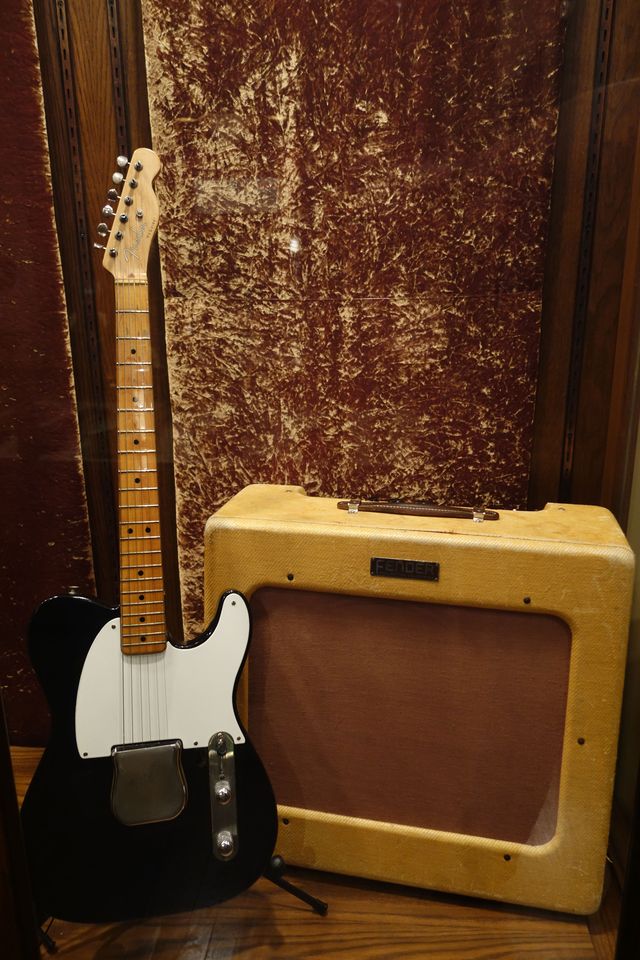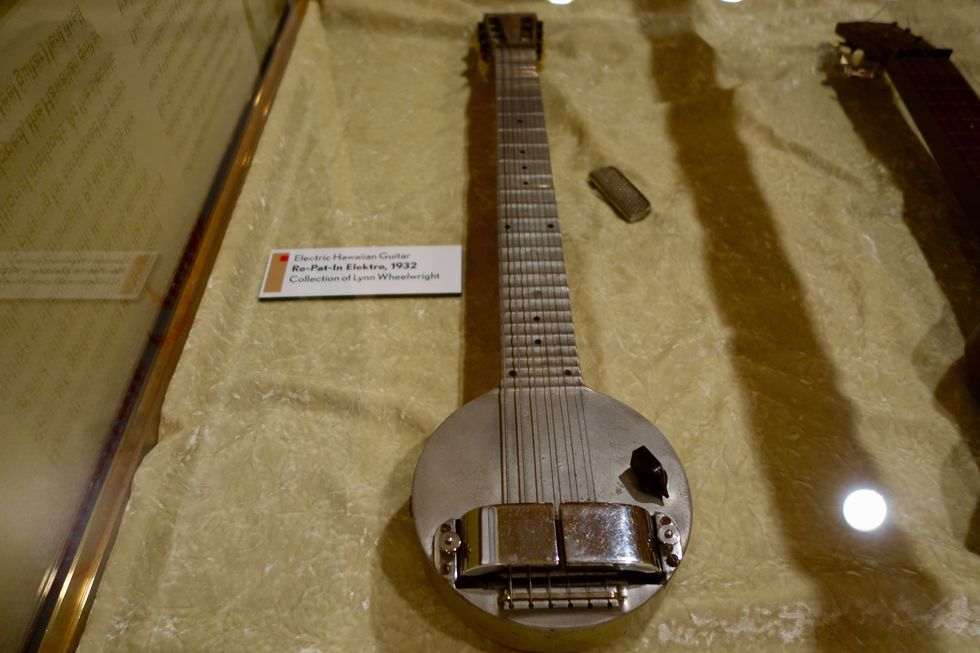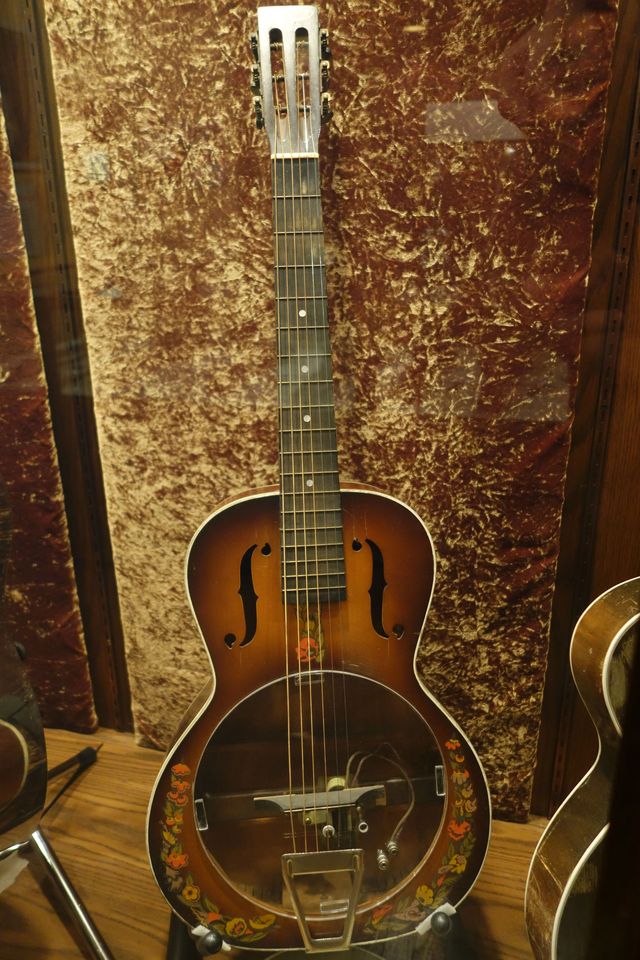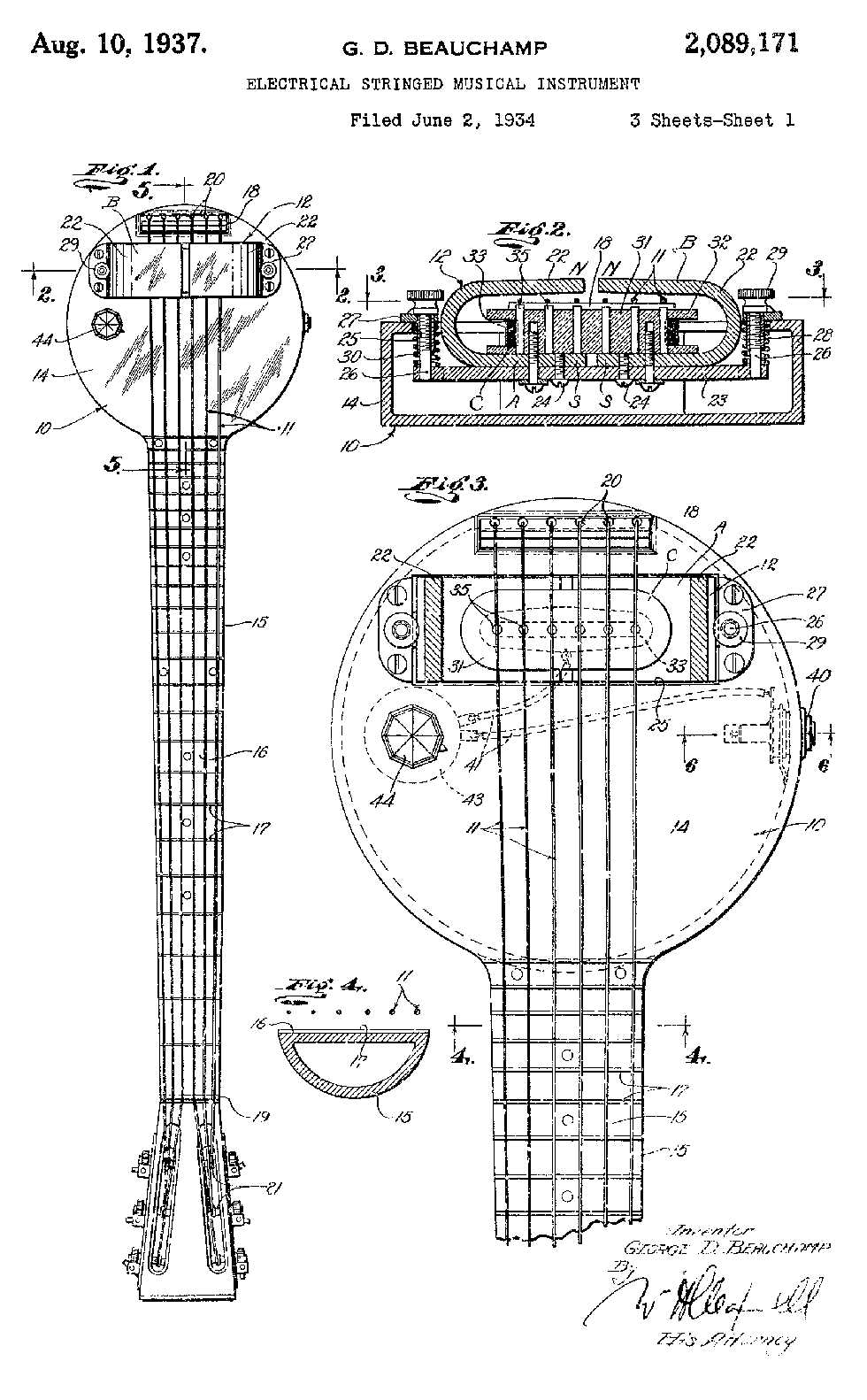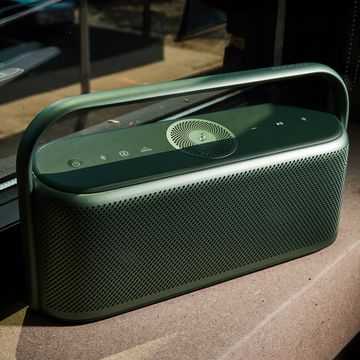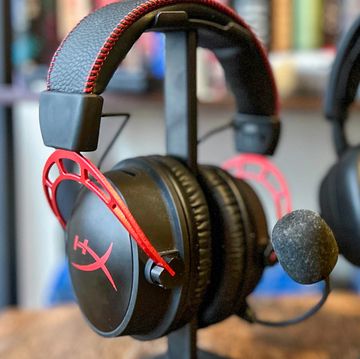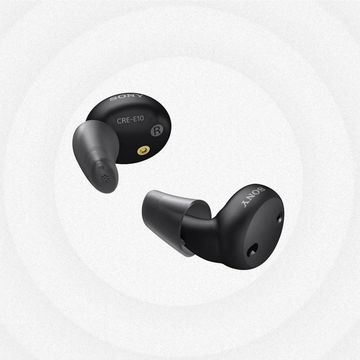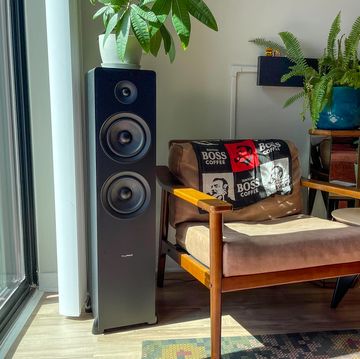You know the Gibson Les Paul: It's that chunky electric guitar hanging off the shoulders of Led Zeppelin's Jimmy Page, the classic axe thrust skyward by Guns N' Roses' lead guitarist Slash.
You know Gibson's great rival Fender, too, even if you don't know guitars. It makes the iconic Stratocaster Jimi Hendrix played and the workhorse Telecasters so often seen in the arms of Bruce Springsteen.
The names of Les Paul and Leo Fender grace many of the most famous electric guitars. Designed in the 1940s and '50s, their instruments helped create the musical world of today, where the electric guitar is ubiquitous and its impact on culture incalculable. But the real origins of the instrument go back further, to a weird and murky prehistory.
It wasn't guitar gods who pioneered this technology. It was amateur radio enthusiasts from the 1920s—garage-bound tinkerers with Popular Mechanics subscriptions and patent aspirations. The story of the instrument shows that its invention, like so many others, was not a neat event when one genius saw a need and created a technology to fill it. It was a messy, scattered process, one that's difficult to piece together even 80 years later.
Somehow, we still don't really know who invented the electric guitar.
Recently, this mystery drew the world's foremost experts to the Wichita-Sedgwick County Historical Museum in Kansas. Over three days, these researchers met to compare findings, dismiss myths, and attempt to settle where exactly the instrument came from. I went to see what they found.
Tinkerers and Rebels
It turns out many of the technologies necessary for the electric guitar were around long before anyone dreamed of a whammy bar or a fuzz box. At the core of the instrument is the electrical principle of induction, which Michael Faraday discovered in 1830. Electric guitars have a pickup (or two or three), which is usually a coil of copper wire wrapped around a magnet. Because of induction, when steel strings vibrate in the vicinity of the pickup, they produce an electromagnetic signal in the copper wire. This signal travels from the guitar through a cable to an amplifier, which increases the signal strength and sends it to a speaker.
The principle of induction is so simple and useful that devices based on it were widespread even before the 1900s. Telegraph keys used it, and some telephones did, too, though the first ones used primitive carbon mics. (The word "phony" comes from the awful facsimile of human speech produced by the early telephone.) Human communication was crucial in spreading the technology that would eventually become the electric guitar. "No one would have cared about this if it wasn't initially about talking," Lynn Wheelwright, a guitar historian and collector, explained in Wichita.
Curiously, it doesn't seem like musicians were the ones who dreamed up the idea of an electrified instrument. Rather, it was the legions of amateur tinkerers who started taking apart products like the telephone, radio, and phonograph and seeing what they could do. Some of the uses they imagined now seem bizarre. A 1919 magazine ad offered a device for amplifying sounds, which, it said, could be used to amplify a violin—or to spy on people. Another magazine from 1922 touted an amateur-built "radio violin": basically a stick with a string and a telephone pickup connected to an amp and a metal horn. "Weak tones can be amplified by a radio loudspeaker," the caption explained. Later that decade, a few proto-rock-'n'-rollers figured out that by shoving a phonograph needle into the top of their acoustic guitar, they could get sound to come out of the speaker. They were a long way from "Free Bird," but the basic idea was there.
Electrified
The notion of an electrified guitar goes back to at least 1890, to an instrument patented by an American Naval officer named George Breed. Breed's design, like most of the earliest electric instruments, didn't use volts to produce volume. Rather, it employed electricity to have the machine play the instrument. It was a self-playing guitar more than a century before the self-driving car.
Matthew Hill, who studies the history and development of musical instruments, built a replica of Breed's guitar based on its patent, and found that the complex electromagnetic system actually vibrates the strings. The guitar plays itself, in other words, producing an ethereal, metallic drone. The replica weighs more than a dozen pounds and is entirely impractical.
At the conference in Wichita, Hill used this replica to argue that novelty—not the pursuit of more volume—was what drove the first electric guitar makers. "Everything you know is wrong," Hill said gleefully, raising hackles among a roomful of guitar geeks. The Breed guitar wasn't meant to be louder, or better-sounding, or useful. It was meant to show what cool things electricity could do.
On the other hand, some evidence suggests that chasing loudness was key. On Oct. 20, 1928, an article appeared in The Music Trades announcing the arrival of an important new product: "an electronically operated device that produces an increased volume of tone for any stringed instrument." This was the Stromberg Electro, perhaps the first-ever commercial pickup. In the following year's edition of the Chicago Musical Instrument catalog, Stromberg boasted about an electric guitar and matching amplifier. "Every tone is brought out distinctly and evenly, with a volume that will fill even a large hall," the ad claimed.
And then Stromberg Electro vanished. Experts have found no other mentions of the company from this period, and no instruments to prove that any models were actually produced. (Wheelwright thinks one of his guitars might have an old Stromberg pickup, but he's not sure.) It's as if, after heralding the arrival of a new era in music, its progenitor suddenly vanished.
In the 1930s, after Stromberg's disappearance, the race to build a real electric axe heated up. The concept for a successful commercial model may have arrived as early as 1931, when the Ro-Pat-In Company of Los Angeles (which eventually became Rickenbacker) built its first electric prototype. Ro-Pat-In's George Beauchamp had developed an electromagnetic pickup that sensed the vibrations of metal strings, and the company built a wood-bodied test model commonly known as the Frying Pan for its round body and long neck. But the cast-aluminum production version of the Frying Pan didn't hit the market until the late summer or early fall of 1932.
By then, Ro-Pat-In wasn't alone. Lloyd Loar, a former engineer at the Gibson instrument company in Michigan, began developing his own pickup in the '20s. The latest research from Arian Sheets, a curator at the National Music Museum in South Dakota who came to the Wichita conference, shows that Loar's firm, Vivi-Tone, built an electric guitar that could be played and purchased by summer 1932. Alvino Rey, a popular bandleader and pioneering electric guitarist, was performing with the instrument onstage later that year. By early 1933, he was shown in national magazines with it.
Grandfather of the Gitbox?
So which of these instruments is the first true electric guitar? Stromberg seems to have been first to market, but no one can say how many instruments it made or sold. Rickenbacker and Vivi-Tone were in a close race. But while all these firms created an electrically amplified guitar, their designs were strikingly different.
The Stromberg Electro (or what experts think might be a Stromberg) relies on the vibrations of the wooden guitar body to move a small metal actuator, which is charged by two heavy horseshoe magnets and interacts with a coil of wire. This system is heavy, indirect, and complex. It doesn't produce a lot of volume. Loar's Vivi-Tone pickups are smaller but work essentially the same way—by amplifying the vibrations of the guitar body and bridge rather than the strings. Sheets showed us a video recording of T. Wilson King playing a Vivi-Tone guitar and it sounded thin and reedy.
The pickup in the Ro-Pat-In, by contrast, works exactly like pickups today: It sits near the strings and collects their vibrations, producing a familiar tone. "It actually sounds amazingly modern," the musician and writer Deke Dickerson said in Wichita as he strummed one of the earliest Ro-Pat-Ins. "You could gig with this guitar." Wheelwright looked on, seeming pleased. "This just proves that the electric guitar and pickup really haven't gone anywhere since 1932," he said.
"Who invented the electric guitar?", then, is a loaded and slippery question. And frankly, it depends what you mean by "electric guitar." If you men applying electricity to the design of a guitar, then the answer could reach back to the 1800s. If you mean the first model to come to market, then maybe it's the Stromberg Electro. Maybe. And if you mean the first to function like the electric guitars of today, then the Ro-Pat-In has the strongest case.
Incidentally, the later years of electric guitar are no clearer. You think the obscure 1930s Slingerland Songster was the first solid-body electric? Others say it was Vivi-Tone, or maybe Ro-Pat-In. You think Leo Fender invented the electric bass guitar? Have you heard of Audiovox and Paul Tutmarc? What about humbucking pickups—now common but made famous on the Gibson Les Paul. Surely, as popular lore goes, Gibson engineer Seth Lover invented them in the mid-1950s. Well, no: The earliest humbucking pickup actually appeared in a patent for a telephone transmitter in 1887.
If you're feeling confused, don't worry—the historians in Wichita were no better off. Throughout the gathering, it seemed none of the experts could make any claim of first-ness without being immediately contradicted. Peer far back into the origins of a technology and you find fascinating antecedents, and ever more uncertainty.
When a fellow expert questioned his claim about the Breed guitar—that it was novelty and not volume that drove the electric guitar's inventors—Hill shouted, semi-sarcastically, "Are you trying to impose a narrative on history?" Everyone laughed—maybe a little too hard—at this distillation of the historian's predicament. The origin of the electric guitar stubbornly resists the imposition of a neat storyline. The question of who really invented the instrument, and when, only really leads to more questions. "We're going to be arguing over this for another 80 years," Hill said. "And that's not a bug, that's a feature."

